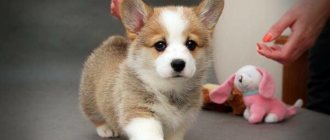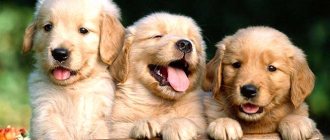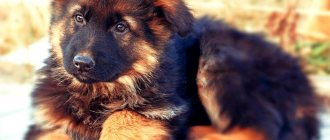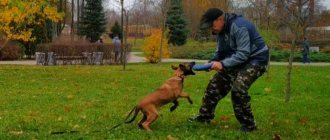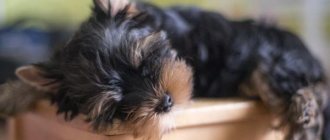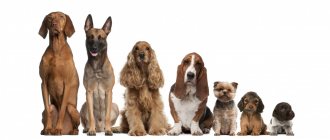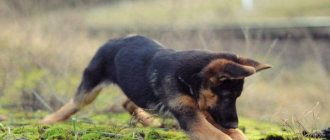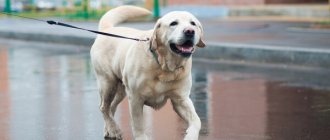If you decide to get a dog, it is best to take a puppy under three months of age. After all, it is during this period that basic behavioral habits and skills are laid, and phobias are formed.
At this time, puppies are easy to train. They are accustomed to a new family and owner, feeding, discipline, hygiene, walking and basic commands. Since puppies of this age respond well to positive emotions, it is best to train them using the “carrot” method. This could be a small treat given after each positive result.
Puppies can be taught a lot at an early age. For example:
- Don't jump on people;
- Sleep at night and behave calmly;
- During a walk, do not run far from the owner;
- Calmly wait for the food to be served;
- Do not chew shoes and clothes;
- Learn the necessary commands “fu”, “place”, “near”, etc.
Meet the family
The puppy gets used to the new family and place of residence through communication and spending time together. It is very important to treat your new pet with care and kindness. Do not make your puppy feel timid, afraid and helpless, and then he will trust you. It is under such conditions that the so-called good contact arises.
During this period, it is very important to form close contact between the owner and the animal. This will speed up the process of training, educating and training the dog. Therefore, it is the owner who must devote the greatest amount of time to the dog and teach basic skills. The rest of the family can participate in raising the puppy, but only when necessary.
Whether contact has been established can only be determined by the dog’s behavior. If she whines, waits at the door during your absence, runs after you, caresses you, strives to play with you and attracts your attention in every possible way, then you have succeeded.
What you need to teach a puppy at the age of 2-3 months
At first, it is best to keep your pet in a box or crib with sides; their presence will give a feeling of reliability and safety. Some people mistakenly refer to sheathing as a “dog prison,” but they are wrong. Of course, at first the pet may be dissatisfied that his movements are limited, but very soon he will understand that he is placed in a crate for sleeping or just resting - after all, any dog also needs privacy. Having accustomed your pet to being in a confined space, you can easily transport your baby in a car or to the veterinarian.
At 2-3 months, the puppy cannot fully control his bladder. And some breeds can’t hold back for up to six months. Toilet problems begin as soon as you bring a new family member home. Establish the correct toilet option from the very beginning and the puppy will adapt as soon as his organs begin to obey.
There are several options for dog toilet:
- special pallet;
- an “ex-feather” handle that the puppy will learn to open and exit;
- mini door leading to the courtyard;
- regular withdrawal by the owner.
You can choose the method that works best for your dog.
Regular feeding
Establishing a routine begins with feeding. Regular provision of access to water, as well as feeding, does not require special knowledge or skills from you. It's just a necessity of life. Moreover, when a puppy is taken away from its mother, breeders already accustom it to a wide variety of food. It is important to feed and water your pet regularly, at approximately the same time. In addition, it is necessary to provide a high-quality diet that contains the amount of food, vitamins and microelements necessary for his age, breed, size.
Underfeeding or overfeeding should not be allowed. In the first case, this will negatively affect the development of the puppy, and in the second, it will affect the digestive system and provoke obesity.
Place
A new pet must be accustomed to its place from the first days of life in your home. This is a specially equipped area where the dog will rest and sleep. It also serves as a temporary “shelter” in situations where the dog may disturb people (cleaning, eating, etc.).
An obedient dog is not difficult!
The “My Puppy” course will help you raise your puppy into the dog of your dreams.
sign up for a course
It is not difficult to accustom a small puppy to its place, but it will take a lot of time. To begin with, every time your pet goes to bed somewhere, you need to move it to its place. Moreover, you need to place it directly on the mat immediately after the “Place” command. When you have already put it down, you need to repeat the command and pet the puppy.
At first, the puppy will try to run away, but it’s worth holding him for a while, repeating the “Place” command and petting him again. Then you can let go. For the best effect, this exercise must be repeated about 4 times a day.
This can be done not only during sleep. You also need to develop the skill of leaving on command. This will come in handy when the puppy begs for food at dinner or plays with the vacuum cleaner while cleaning. You just need to take into account that leaving on command is somewhat more complicated than just sleeping in one place. If it was not possible to teach this at the age of 1-3 months, then it is better to try again a little later.
Training and games with a puppy: rules
To prevent the game from ending in bites or damage to property, you should follow a few simple rules for preparing for it:
- before starting classes, your pet needs to be fed;
- It is better to play with him in a well-ventilated room or outside;
- Stock up on special toys for puppies in advance. They will help make the game more varied, and your pet will gradually develop motor skills and muscle strength.
Observe what your baby is most interested in. The exercises themselves need to be constantly changed and breaks taken during the game. The puppy quickly becomes overexcited and loses control, so classes should be short but exciting. Do not forget that your cheerful company is important to your baby.
Hygiene
Washing and cleaning must be taught from an early age. There are usually no difficulties in this. You just need to do everything carefully, without harming the baby. The water temperature should be comfortable for the dog; cold or hot water is not allowed. Then bathing will evoke only positive emotions, and the already mature dog will willingly run to the bathroom. This also applies to cutting or combing. The main thing is to be careful, because any pain and fear has its consequences. After some negative experience, the pet simply does not want to repeat the procedure again.
Punishment
Many people are interested in: “What can and what can’t you punish a little puppy for?” At this age it is better to do without punishment. They definitely will not give the required result, and the nervous system and mutual understanding will be damaged. We strongly recommend that you learn the list of things you should absolutely not punish a 3-month-old puppy for.
- Heaps and puddles at home. At this early age, the daily routine has not yet been adjusted, and one has not yet learned to tolerate it.
- Damaged material assets and things. You cannot blame the puppy for damage. Most likely, you didn’t remove it, forgot it, or left it in a visible place. All valuables should be kept out of reach. And if you have exposed wires and cables, take care of cleaning them up immediately. This is a favorite toy of small puppies, and it is also unsafe.
- Running and active games. At this age, puppies are distinguished by their mobility. They have more than enough energy. It is better to walk your pet more often.
- Biting off wallpaper and pieces of walls. If your dog regularly chews or licks walls, you should consult a doctor. He may be lacking minerals.
- Playing with the hands and feet of family members. This habit is characteristic only of small puppies, and as they grow older, it goes away. Usually such games become uninteresting to him after 4 months.
Do you have a special situation?
Our specialists met with everyone. They share their experiences in detail in our online school!
more details
How to teach a dog to recognize the names of toys
Playing with puppies at home must include a learning process. It’s good if the pet can hear by ear what object the owner is asking him to bring. Accordingly, it is necessary to teach the animal to recognize the names of different toys.
This is done quite simply. You just need to repeat the name of the object every time during the game and show it to your pet, for example, “ball”. Soon the dog will begin to associate this word and object.
Checking how well the training is going is also quite easy. You just need to ask your pet to bring a toy. If he did, then the lesson was learned.
Promotion
As we said earlier, a small puppy needs to be constantly encouraged. It is important to always carry some kind of treat with you, and reward the baby for any positive result in training (following a command, obedience, etc.).
Hard cheese is perfect for small puppies. You need to cut it into small pieces and always have it with you. Moreover, it is very important to think about the size of the treats. After all, the baby will not taste a piece that is too small and will no longer be interested, but a large piece will satisfy him the first time. In this case, motivation also disappears.
The optimal treat is something the size of a small pea. Moreover, regular dry food will not work. After all, it is given strictly according to the dosage, and the puppy can choke on the dried food. And the cheese is suitable because it does not stain your pockets, is easy to cut and dries. And dogs simply adore him.
These are the basic rules for raising and training small puppies. Follow them and then you will quickly find mutual understanding with your new favorite.
Types of Puppy Play
Games with puppies can be educational and educational. The first includes daily activities with a ball, a bone, a soft toy, latex products, and any safe household items. They train the dog’s attention, teach them to behave correctly in a group and not to be an aggressor. Teach your dog to fetch a toy, but do not take it away by force. For a completed command, praise or treat him with a treat.
Developmental
The most popular educational games with a puppy include the following:
- Hide and seek. You can play with toys and with people. You show a toy or treat and say “Look!” If the puppy does not understand, you need to take him to the place of the hidden object and show it. Outside, you can hide behind a tree and watch the puppy looking for you. When he is nearby, go out and say “Come to me.” If successful, be sure to reward your dog with something tasty.
- Catching up. Play with your puppy outside: run to a certain place nearby, and when you reach your goal, praise your pet. When you run away from the puppy, rather than him running away from you, he understands your leadership faster.
- Playing with a plate, ball, disc or frisbee. Throw one of the objects away so that the dog brings it back. Repeat until he gets tired. Each time he returns to you, give him a couple of minutes to hold the toy in his teeth. Then say “Quit” to get him to give in. If that doesn’t work, carefully remove it from your mouth and cheerfully say “Drop it” again. This way the puppy will learn three commands: come to me, bring it, throw it.
- Nose work on the street. Find a tree with textured bark and place a treat there at the level of the puppy's head. Then change its position, hiding it at the bottom, then at the top, so that the baby bends over or stands on his hind legs.
It is best to use a set of gaming exercises.
On the street you can play hide and seek: show your favorite toy, hide it and ask to find it.
Educational
The second category includes educational games with training elements. In each game, you can teach your puppy the commands “Give paw”, “Fetch”, “Sit”, “Look”, “Serve”, “Fetch” and others. For example, ask your dog to sit and show him the treat just above his nose so he can reach it from a sitting position.
Another game called “Agility” helps to find out how much the puppy understands the owner. It overcomes obstacles using voice commands. This is considered the highest stage of training, when the dog and the person work as a team.
Educational games help the puppy distinguish between praise and blame, direct its attention, teach it to understand gestures and glances, and help it become more attached to its owner. Training and playing with your puppy is an important part of raising a dog.
By playing with your pet, you not only make his life more varied, but also socialize him. And if he himself invites you to play, do not refuse the true pleasure of communicating with him.
